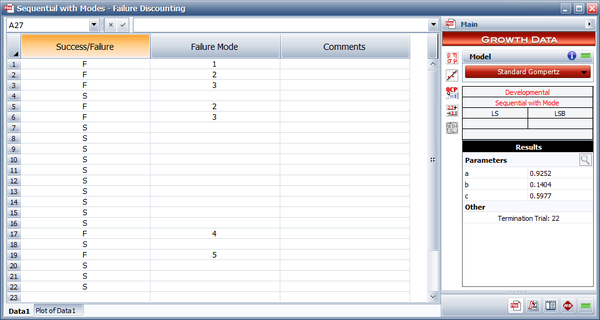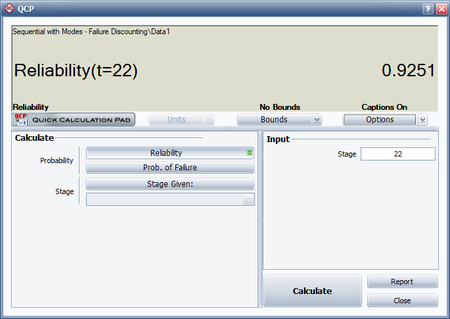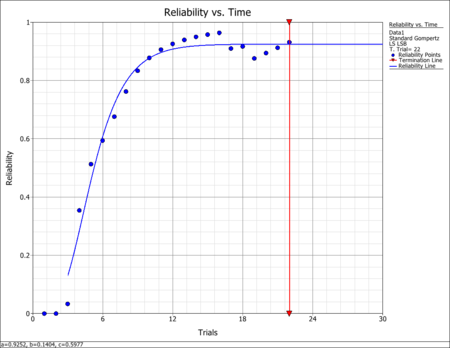Failure Discounting: Difference between revisions
No edit summary |
Lisa Hacker (talk | contribs) No edit summary |
||
| (29 intermediate revisions by 6 users not shown) | |||
| Line 1: | Line 1: | ||
{{ | {{Template:RGA_BOOK|Appendix A|Failure Discounting}} | ||
During a reliability growth test, once a failure has been analyzed and corrective actions for that specific failure mode have been implemented, the probability of its recurrence is diminished, as given in Lloyd [[RGA_References|[4]]]. Then for the success/failure data that follow, the value of the failure for which corrective actions have already been implemented should be subtracted from the total number of failures. However, certain questions arise, such as to what extent should the failure value be diminished or discounted, and how should the failure value be defined? One answer would be to use engineering judgment (e.g., a panel of specialists would agree that the probability of failure has been reduced by 50% or 90% and therefore, that failure should be given a value of 0.5 or 0.9). The obvious disadvantage of this approach is its arbitrariness and the difficulty of reaching an agreement. Therefore, a statistical basis needs to be selected, one that is repeatable and less arbitrary. Failure discounting is applied when using the Lloyd-Lipow, logistic, and the standard and modified Gompertz models. | |||
The value of the failure, <math>f\,\!</math>, is chosen to be the upper confidence limit on the probability of failure based on the number of successful tests following implementation of the corrective action. The failure value is given by the following equation: | |||
The value of the failure, | |||
:<math>f=1-{{(1-CL)}^{\tfrac{1}{{{S}_{n}}}}}\,\!</math> | |||
where: | where: | ||
*<math>CL\,\!</math> is the confidence level. | |||
*<math>{{S}_{n}}\,\!</math> is the number of successful tests after the first success following the corrective action. | |||
For example, after one successful test following a corrective action, <math>{{S}_{n}}=1\,\!</math>, the failure is given a value of 0.9 based on a 90% confidence level. After two successful tests, <math>{{S}_{n}}=2\,\!</math>, the failure is given a value of 0.684, and so on. The procedure for applying this method is illustrated in the next example. | |||
'''Example''' | '''Example''' | ||
{{:Failure_Discounting_Example}} | |||
: | |||
Latest revision as of 20:39, 18 September 2023
During a reliability growth test, once a failure has been analyzed and corrective actions for that specific failure mode have been implemented, the probability of its recurrence is diminished, as given in Lloyd [4]. Then for the success/failure data that follow, the value of the failure for which corrective actions have already been implemented should be subtracted from the total number of failures. However, certain questions arise, such as to what extent should the failure value be diminished or discounted, and how should the failure value be defined? One answer would be to use engineering judgment (e.g., a panel of specialists would agree that the probability of failure has been reduced by 50% or 90% and therefore, that failure should be given a value of 0.5 or 0.9). The obvious disadvantage of this approach is its arbitrariness and the difficulty of reaching an agreement. Therefore, a statistical basis needs to be selected, one that is repeatable and less arbitrary. Failure discounting is applied when using the Lloyd-Lipow, logistic, and the standard and modified Gompertz models.
The value of the failure, [math]\displaystyle{ f\,\! }[/math], is chosen to be the upper confidence limit on the probability of failure based on the number of successful tests following implementation of the corrective action. The failure value is given by the following equation:
- [math]\displaystyle{ f=1-{{(1-CL)}^{\tfrac{1}{{{S}_{n}}}}}\,\! }[/math]
where:
- [math]\displaystyle{ CL\,\! }[/math] is the confidence level.
- [math]\displaystyle{ {{S}_{n}}\,\! }[/math] is the number of successful tests after the first success following the corrective action.
For example, after one successful test following a corrective action, [math]\displaystyle{ {{S}_{n}}=1\,\! }[/math], the failure is given a value of 0.9 based on a 90% confidence level. After two successful tests, [math]\displaystyle{ {{S}_{n}}=2\,\! }[/math], the failure is given a value of 0.684, and so on. The procedure for applying this method is illustrated in the next example.
Example
Assume that during the 22 launches given in the first table below, the first failure was caused by Mode 1, the second and fourth failures were caused by Mode 2, the third and fifth failures were caused by Mode 3, the sixth failure was caused by Mode 4 and the seventh failure was caused by Mode 5.
- Find the standard Gompertz reliability growth curve using the results of the first 15 launches.
- Find the predicted reliability after launch 22.
- Calculate the reliability after launch 22 based on the full data set from the second table, and compare it with the estimate obtained for question 2.
| Launch Sequence with Failure Modes and Failure Values | |||||||||
| Launch Number | Result/Mode | Failure 1 | Failure 2 | Failure 3 | Failure 4 | Failure 5 | Sum of Failures | ||
|---|---|---|---|---|---|---|---|---|---|
| 1 | F1 | 1.000 | 1.000 | ||||||
| 2 | F2 | 1.000 | 1.000 | 2.000 | |||||
| 3 | F3 | 0.900 | 1.000 | 1.000 | 2.900 | ||||
| 4 | S | 0.684 | 0.900 | 1.000 | 2.584 | ||||
| 5 | F2 | 0.536 | 1.000 | 0.900 | 2.436 | ||||
| 6 | F3 | 0.438 | 1.000 | 1.000 | 2.438 | ||||
| 7 | S | 0.369 | 0.900 | 1.000 | 2.269 | ||||
| 8 | S | 0.319 | 0.684 | 0.900 | 1.902 | ||||
| 9 | S | 0.280 | 0.536 | 0.684 | 1.500 | ||||
| 10 | S | 0.250 | 0.438 | 0.536 | 1.224 | ||||
| 11 | S | 0.226 | 0.369 | 0.438 | 1.032 | ||||
| 12 | S | 0.206 | 0.319 | 0.369 | 0.894 | ||||
| 13 | S | 0.189 | 0.280 | 0.319 | 0.788 | ||||
| 14 | S | 0.175 | 0.250 | 0.280 | 0.705 | ||||
| 15 | S | 0.162 | 0.226 | 0.250 | 0.638 | ||||
| 16 | S | 0.152 | 0.206 | 0.226 | 0.584 | ||||
| 17 | F4 | 0.142 | 0.189 | 0.206 | 1.000 | 1.537 | |||
| 18 | S | 0.134 | 0.175 | 0.189 | 1.000 | 1.498 | |||
| 19 | F5 | 0.127 | 0.162 | 0.175 | 0.900 | 1.000 | 2.364 | ||
| 20 | S | 0.120 | 0.152 | 0.162 | 0.684 | 1.000 | 2.118 | ||
| 21 | S | 0.114 | 0.142 | 0.152 | 0.536 | 0.900 | 1.844 | ||
| 22 | S | 0.109 | 0.134 | 0.142 | 0.438 | 0.684 | 1.507 | ||
| Comparison of the Predicted Reliability with the Actual Data | |||
| Launch Number | Calculated Reliability (%) | ln(R) | Gompertz Reliability (%) |
|---|---|---|---|
| 1 | 0.000 | ||
| 2 | 0.000 | ||
| 3 | 3.333 | 1.204 | |
| 4 | 35.406 | 3.567 | 28.617 |
| 5 | 51.283 | 3.937 | 45.883 |
| 6 | 59.372 | 4.084 | 60.841 |
| 7 | 67.585 | 4.213 | 72.017 |
| 8 | 76.219 | 4.334 | 79.654 |
| 9 | 83.334 | 4.423 | 84.600 |
| [math]\displaystyle{ {{S}_{1}}\,\! }[/math] = 24.558 | |||
| 10 | 87.764 | 4.475 | 87.701 |
| 11 | 90.614 | 4.507 | 89.609 |
| 12 | 92.555 | 4.528 | 90.769 |
| 13 | 93.939 | 4.543 | 91.469 |
| 14 | 94.964 | 4.553 | 91.891 |
| 15 | 95.746 | 4.562 | 92.143 |
| [math]\displaystyle{ {{S}_{2}}\,\! }[/math] = 27.167 | |||
| 16 | 96.356 | 4.568 | 92.295 |
| 17 | 90.960 | 4.510 | 92.385 |
| 18 | 91.681 | 4.518 | 92.439 |
| 19 | 87.560 | 4.472 | 92.472 |
| 20 | 89.411 | 4.493 | 92.491 |
| 21 | 91.219 | 4.513 | 92.503 |
| [math]\displaystyle{ {{S}_{3}}\,\! }[/math] = 27.076 | |||
| 22 | 93.152 | 4.534 | 92.510 |
Solution
- In the table above, the failures are represented by columns "Failure 1", "Failure 2", etc. The "Result/Mode" column shows whether each launch is a failure (indicated by the failure modes F1, F2, etc.) or a success (S). The values of failure are based on [math]\displaystyle{ CL=0.90\,\! }[/math] and are calculated from:
- [math]\displaystyle{ f=1-{{(1-CL)}^{\tfrac{1}{{{S}_{n}}}}}\,\! }[/math]
- [math]\displaystyle{ R=\left[ 1-\left( \frac{\mathop{}_{i=1}^{N}{{f}_{i}}}{n} \right) \right]\cdot 100\text{ }%\,\! }[/math]
- Failure 1 is Mode 1; it occurs at launch 1 and it does not recur throughout the process. So at launch 3, [math]\displaystyle{ {{S}_{n}}=1\,\! }[/math], and so on.
- Failure 2 is Mode 2; it occurs at launch 2 and it recurs at launch 5. Therefore, [math]\displaystyle{ {{S}_{n}}=1\,\! }[/math] at launch 4 and at launch 7, and so on.
- Failure 3 is Mode 3; it occurs at launch 3 and it recurs at launch 6. Therefore, [math]\displaystyle{ {{S}_{n}}=1\,\! }[/math] at launch 5 and at launch 8, and so on.
- Failure 6 is Mode 4; it occurs at launch 17 and it does not recur throughout the process. So at launch 19, [math]\displaystyle{ {{S}_{n}}=1\,\! }[/math], and so on.
- Failure 7 is Mode 5; it occurs at launch 19 and it does not recur throughout the process. So at launch 21, [math]\displaystyle{ {{S}_{n}}=1\,\! }[/math], and so on.
- [math]\displaystyle{ \begin{align} {{f}_{1/3}}=1-{{(1-0.90)}^{1/1}}=0.900 \end{align}\,\! }[/math]
- [math]\displaystyle{ \begin{align} {{f}_{1/4}}=1-{{(1-0.90)}^{1/2}}=0.684 \end{align}\,\! }[/math]
- [math]\displaystyle{ \begin{align} c &= \left ( \frac{S_{2}-S_{3}}{S_{2}-S_{1}} \right )^\frac{1}{n\cdot I} \\ &= \left [ \frac{27.167-27.076}{27.167-24.558} \right ]^\frac{1}{6} \\ &= 0.572 \\ \end{align}\,\! }[/math]
- [math]\displaystyle{ \begin{align} a &= e^\left [\frac{1}{n}\left (S_{1} + \frac {S_{2}-S_{1}}{1-e^{n\cdot I}} \right )\right ] \\ &= e^\left [\frac{1}{6}\left (24.558 + \frac{27.167 - 24.558}{1-0.572^{6}}\right ) \right ] \\ &= 94.024% \\ \end{align}\,\! }[/math]
- [math]\displaystyle{ \begin{align} b &= e^\left [\frac{(S_{2}-S_{1})(c-1)}{(1-c^{n})^{2}} \right ] \\ &= e^\left [\frac{(27.167-24.558)(0.572-1)}{(1-0.572^{6})^{2}} \right ] \\ &= 0.301 \\ \end{align}\,\! }[/math]
- [math]\displaystyle{ \begin{align} \widehat{a}&= 0.9252 \\ \widehat{b} &= 0.1404 \\ \widehat{c} &= 0.5977 \end{align}\,\! }[/math]
The Gompertz reliability growth curve may now be written as follows where [math]\displaystyle{ {{L}_{G}}\,\! }[/math] is the number of launches, with the first successful launch being counted as [math]\displaystyle{ {{L}_{G}}=1\,\! }[/math]. Therefore, [math]\displaystyle{ {{L}_{G}}\,\! }[/math] is equal to 19, since reliability growth starts with launch 4.
- [math]\displaystyle{ R=0.9299{{(0.0943)}^{{{0.7170}^{{{L}_{G}}}}}}\,\! }[/math]
- The predicted reliability after launch 22 is therefore:
- [math]\displaystyle{ \begin{align} R &= 0.9252{{(0.1404)}^{{{0.5977}^{19}}}} \\ &= 0.9251 \end{align}\,\! }[/math]
- In the second table, the predicted reliability values are compared with the reliabilities that are calculated from the raw data using failure discounting. It can be seen in the table, and in the following figure, that the Gompertz curve appears to provide a good fit to the actual data.



